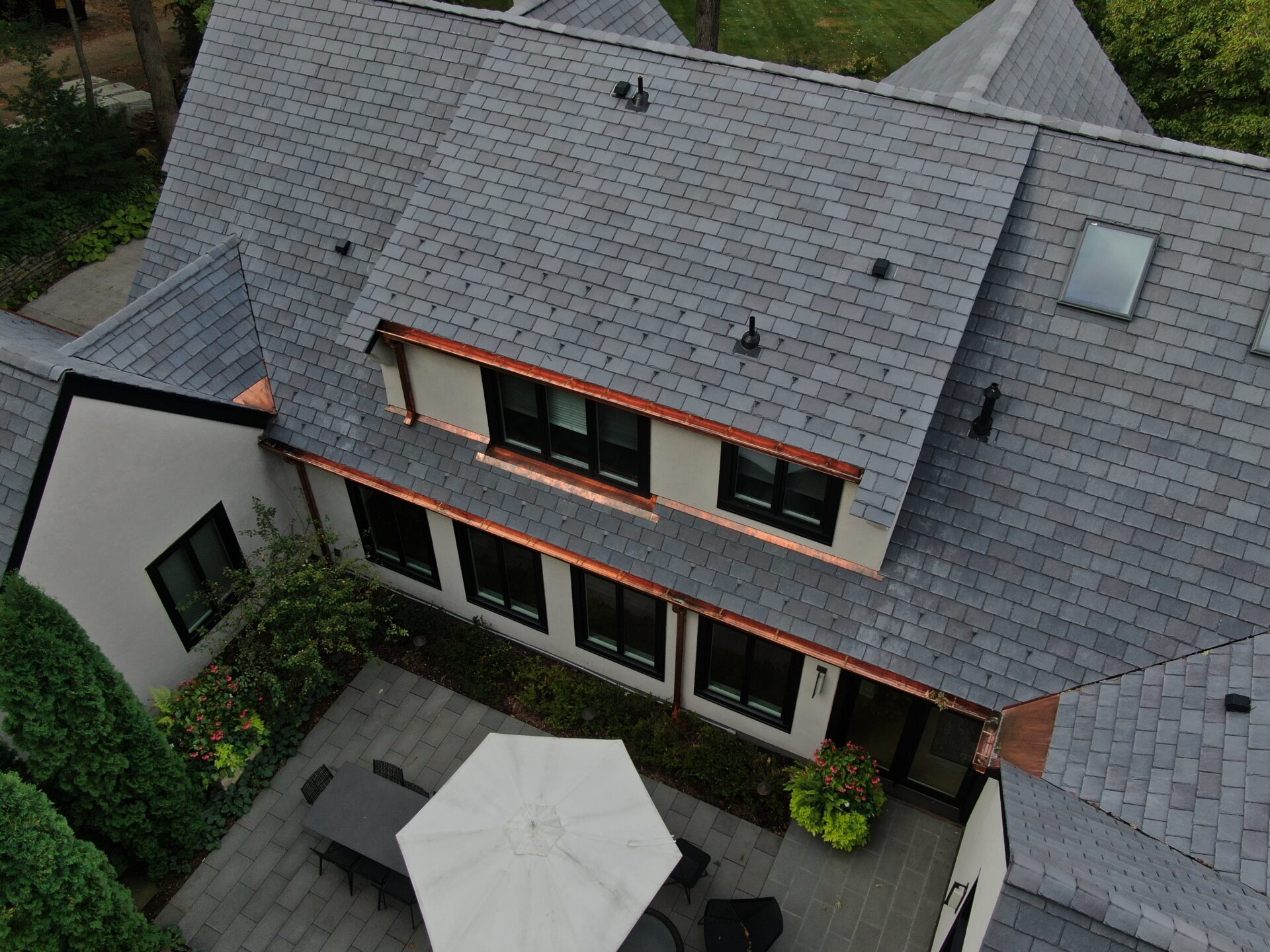Although resilient, every tile roof is susceptible to natural wear and tear over time. So, when the time comes to repair roof tiles, what should you do?
In this article, we’ll go over how to repair and replace roof tiles. But first, let’s talk about what causes a tile roof to eventually take its toll.
Reasons why you may need to repair roof tiles
Tile roofs are typically pretty durable, but they’re certainly not bulletproof. Like nearly every other material, there’s always the threat of damage and deterioration. For example, this is why the average roof life in Minnesota falls around 20 years.
So, let’s go over three common culprits that will likely call for a roof repair in the future.
The weather is unkind
It’s no secret that harsh weather can be pretty rough on roofs. The outdoor elements don’t discriminate, and thus, they can damage all types of commercial roofs.
High winds, frost, and long-term moisture will inevitably cause harm to a roof tile. Extremely heavy winds could even fully dislodge a tile from its wooden batten. This is because tree branches or other debris can fall onto a roof and damage tiles during intensely windy days. Needless to say, it’s safe to assume you’ll have to repair roof tiles at some point if you’ve experienced episodes of crazy weather.
Your roof wasn’t installed correctly
A roof needs to be constructed so it can stand up to harsh elements. If it’s not designed and implemented properly, it may leave the tiles at risk for damage during volatile weather conditions. Additionally, whichever commercial roofing service you’ve used in the past could have accidentally damaged the roofing structure during the construction process.
Furthermore, if you’ve just purchased a new home and are noticing tiles fall off, it’s likely that they weren’t installed correctly. Improper installation can be caused by several factors. For instance, the professional roofer you hired could have used tiles that weren’t appropriately rated for the slope of your roof. Or, perhaps they neglected to put in the necessary work to effectively secure each tile.
Thus, if your roof wasn’t installed correctly, you’ll probably need to repair roof tiles down the road.
You treat your roof like a dance floor
Commercial roof types aren’t meant to be walked on. Even though concrete and clay tiles are pretty durable, they’re not designed for humans to walk all over. Thus, any applied weight on the tiles after they’re installed can lead to breaks.
Unlike every 90s movie that featured a summer party scene, you shouldn’t hang out on your roof with your buddies– as fun as it might seem. You also should be conscientious if you ever have to walk on your roof to install or fix something (like a roof tile or a satellite dish). Rather, consult a pro to help you out in these situations.
Fix your roof before it falls apart
The worst thing you can do when you notice cracks or loose tiles on your roof is wait. Just as neglecting to see the dentist when you have tooth pain can lead to a total tooth replacement, waiting to repair your roof can result in a roof tile replacement or a complete roof renovation. This will only cost you more time and money.
So, to quote the Little Red Riding Hood, if the big bad wolf can “huff and puff and blow your house in”– your roof isn’t strong enough. And you need to fix it ASAP to prevent further damage in the future. Luckily, when damage does occur to a roof, it usually affects tiles individually. This means that you can either repair or replace a tile without having to compromise the entire roofing structure.
To keep your roof in the best possible shape and ensure its longevity, follow the below tips.

default
Repair roof tiles that have tiny cracks
If one of your tiles just has a small crack in it, it’s not too difficult to fix. Although, you must still practice extreme caution any time you go on your roof.
The first step in “How to repair cracked roof tiles” is to clean out the crack to prep it for roofing cement. Use a wire brush to scrub into the crack so the roofing cement can bond adequately. If there’s still dirt or debris in the crack, the cement won’t be able to sufficiently adhere to the tile and seal the crack.
Once you’ve completed the cleaning, fill the crack with special plastic roofing cement. However, if the crack isn’t too large, you can also use silicone caulk to seal it. After it’s been sealed, use a trowel to smooth over the surface of the roof tile to the adjoining level. Then, all you have to do is wait for the cement to harden.
If you need to replace a broken roof tile
Sometimes, filling a crack with roofing cement isn’t enough to do the trick. If the crack is so big that it runs across the entire length of the tile or makes the whole tile loose, it’s time to replace the tile.
When a commercial roof replacement process only involves a few tiles that need replacements, it includes five steps that ensure the new tiles are installed correctly. So, let’s go over each one.
1. Find the right kind of tile
When you can’t repair roof tiles and need to replace a tile altogether, the first step you need to do is source the right type of tile for your roof. Look for a tile that’s the same size and made from the same material as your other roof tiles. Also, look at the different commercial roof coatings to make sure the finish of the new tile will blend in seamlessly with the others. If you start your commercial roof installation with a replacement tile that’s not an exact match, you’ll fall victim to more damage down the line.
2. Remove the broken tile
When you need to remove rather than repair roof tiles, the second step is to remove the faulty tile. Use a hammer or a flat bar to break the defective tile off the structure. Make sure you also remove any residual tile pieces and nails.
3. Lift the surrounding tiles
Unlike the step above where you deliberately break the faulty tile, you need to know how to remove roof tiles without breaking them for all of the surrounding tiles. Since you have to get the adjacent tiles out of the way to replace the faulty tile, you must prop them up so they’re not overlapping the space where the new tile will go.
To prop up the surrounding tiles, use a couple of woodblocks and a trowel. Be careful not to lift the tiles too far, as this could cause damage. Instead, slightly elevate them using the woodblocks. Then, once the new tile is settled, you can lower the surrounding tiles back into place.
4. Add roofing cement
Just like when you repair roof tiles, you need to use roofing cement when you replace a broken tile. On the backside of the new tile, spread a small quantity of roofing cement and then slide it into place. You won’t need to use any nails since adhesive alone will bond the replacement tile to your roof.
5. Secure the new tile
Once you’ve slid the replacement tile into place, check to ensure it’s not interfering with the adjacent tiles. It needs to be securely slotted in a slightly overlapping position. If you see any gaps, it means it isn’t placed properly. But, if everything looks good, press down on the tile firmly while still being gentle.
Repair roof tiles with the help of a professional
While replacing roof tiles certainly can be a DIY project, it’s not recommended because of how dangerous working at a great height is. Plus, since you’re not a roofing expert, you could unintentionally cause more damage during the process. So, just like getting a tooth replacement, the best way to replace or repair your roof is to have a professional do it.
Choosing one of the top roofing companies in Minnesota, such as Summit Construction Group, will ensure your roof is fixed correctly without causing additional damage. Plus, an expert will be able to see other potential issues, like roof leaks or other faulty tiles you may not have noticed.
A roofing company in Edina you can trust
Whether you need to repair roof tiles or need a new roof installation, working with Summit Construction Group roofing experts is your best bet at getting the job done effectively.

